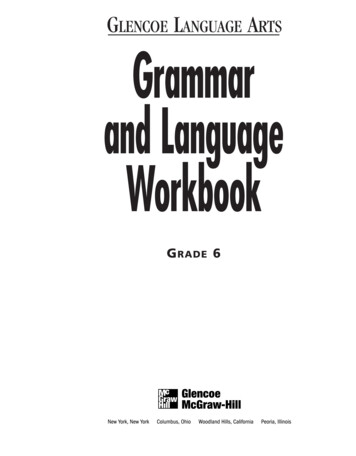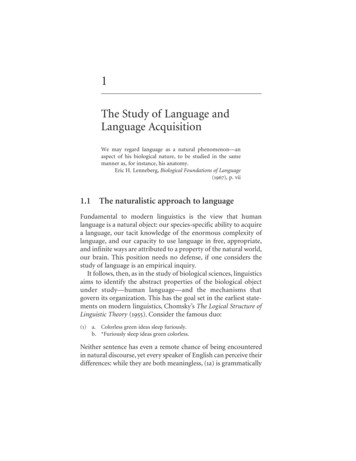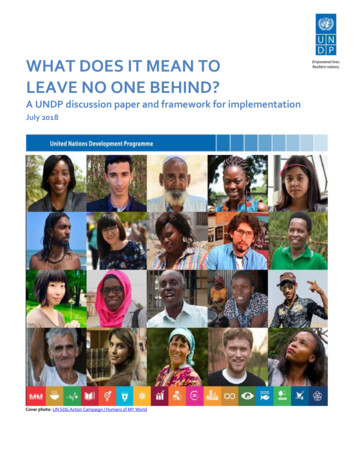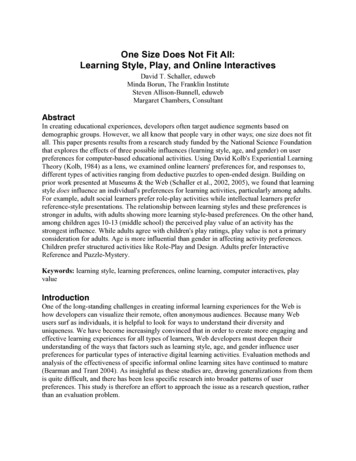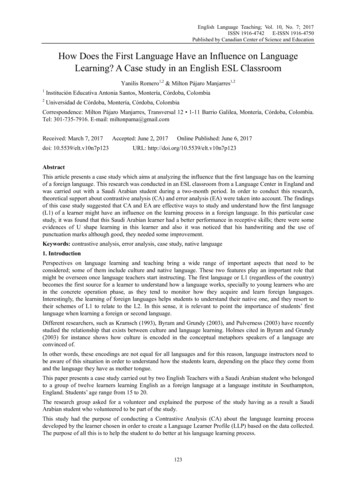
Transcription
English Language Teaching; Vol. 10, No. 7; 2017ISSN 1916-4742E-ISSN 1916-4750Published by Canadian Center of Science and EducationHow Does the First Language Have an Influence on LanguageLearning? A Case study in an English ESL ClassroomYanilis Romero1,2 & Milton Pájaro Manjarres1,21Institución Educativa Antonia Santos, Montería, Córdoba, Colombia2Universidad de Córdoba, Montería, Córdoba, ColombiaCorrespondence: Milton Pájaro Manjarres, Transversal 12 1-11 Barrio Galilea, Montería, Córdoba, Colombia.Tel: 301-735-7916. E-mail: miltonpama@gmail.comReceived: March 7, 2017doi: 10.5539/elt.v10n7p123Accepted: June 2, 2017Online Published: June 6, 2017URL: http://doi.org/10.5539/elt.v10n7p123AbstractThis article presents a case study which aims at analyzing the influence that the first language has on the learningof a foreign language. This research was conducted in an ESL classroom from a Language Center in England andwas carried out with a Saudi Arabian student during a two-month period. In order to conduct this research,theoretical support about contrastive analysis (CA) and error analysis (EA) were taken into account. The findingsof this case study suggested that CA and EA are effective ways to study and understand how the first language(L1) of a learner might have an influence on the learning process in a foreign language. In this particular casestudy, it was found that this Saudi Arabian learner had a better performance in receptive skills; there were someevidences of U shape learning in this learner and also it was noticed that his handwriting and the use ofpunctuation marks although good, they needed some improvement.Keywords: contrastive analysis, error analysis, case study, native language1. IntroductionPerspectives on language learning and teaching bring a wide range of important aspects that need to beconsidered; some of them include culture and native language. These two features play an important role thatmight be overseen once language teachers start instructing. The first language or L1 (regardless of the country)becomes the first source for a learner to understand how a language works, specially to young learners who arein the concrete operation phase, as they tend to monitor how they acquire and learn foreign languages.Interestingly, the learning of foreign languages helps students to understand their native one, and they resort totheir schemes of L1 to relate to the L2. In this sense, it is relevant to point the importance of students’ firstlanguage when learning a foreign or second language.Different researchers, such as Kramsch (1993), Byram and Grundy (2003), and Pulverness (2003) have recentlystudied the relationship that exists between culture and language learning. Holmes cited in Byram and Grundy(2003) for instance shows how culture is encoded in the conceptual metaphors speakers of a language areconvinced of.In other words, these encodings are not equal for all languages and for this reason, language instructors need tobe aware of this situation in order to understand how the students learn, depending on the place they come fromand the language they have as mother tongue.This paper presents a case study carried out by two English Teachers with a Saudi Arabian student who belongedto a group of twelve learners learning English as a foreign language at a language institute in Southampton,England. Students’ age range from 15 to 20.The research group asked for a volunteer and explained the purpose of the study having as a result a SaudiArabian student who volunteered to be part of the study.This study had the purpose of conducting a Contrastive Analysis (CA) about the language learning processdeveloped by the learner chosen in order to create a Language Learner Profile (LLP) based on the data collected.The purpose of all this is to help the student to do better at his language learning process.123
elt.ccsenet.orgEnglish Language TeachingVol. 10, No. 7; 2017After identifying different needs, wants and lacks in this Saudi Arabian Learner, the researchers created a set ofactivities to help the learner cope with skills such as reading and listening. The importance of this piece ofresearch is intended to raise awareness about a major inquiry underlying the teaching process dealing withplanning, a phase in which instructors need to consider the heterogeneity of the target audience and thecomplexity of each students’ needs.1.1 How Does the First Language Have an Influence over the Learning of a New Language?Language is essential if we want that habits, institutions and beliefs acquire the meaning of what we call culture.In fact, these aspects must have meaning to become culture. According to Kramsch (2013) language, not seen asa linguistic system, but seen in context is: “a coherent symbolic system for making meaning” (Kramsch, 2013:62). In this sense, we cannot separate the study of language and language learning from culture and the contextthat surrounds the learner, especially when we refer to the learning of a foreign language.Besides culture, the first language (L1) of a learner might have an influence over foreign language learning,either by acting as a source for the learner to understand how the language works when the first language and theforeign language are similar (transfer), or by being a factor of interference if the two languages are very different(negative transfer) (Celaya, M., n.d).Although some authors such as Krashen (1982) and Dulay and Burt (1974) claim that the process of learning theL2 is similar to the one of learning the L1, some researchers like: Kellerman and Sharwood-Smith (1986) use theterm “Crosslinguistic influence” to refer to aspects of language learning such as: transfer, avoidance andborrowing renewing the ideas of transference that appeared in the 50 s and 60 s giving some support to the ideasstated by Lado (1957) who stays that: “individuals tend to transfer the forms and meanings ( ) of their nativelanguage and culture to the foreign language and culture” (Lado, 1957 cited in Celaya, n.d. :1)The following case study presents an analysis on how the first language of a Saudi Arabian student learningEnglish had an influence over his language learning process. The purpose of this analysis was to show Englishteachers how having an understanding of the influence that the L1 has over the learning of a second language canhelp to select better teaching materials, prepare more suitable lessons and give more effective instructions to ourstudents1.2 Contrastive AnalysisOne of the key aspects that needs to be considered when talking about the influence that the L1 has over thelearning of a foreign language is contrastive analysis (CA). According to Johansson (2008) contrastive analysiscan be defined as: “the systematic comparison between two or more languages, with the aim of describing theirsimilarities and differences”. (p. 9) This kind of analysis usually has a pedagogical purpose and it is usuallycarried out to have better descriptions of the learners’ performance and select better teaching materials for thelearners. When someone is learning a foreign language, it is common to make mistakes in pronunciation orgrammar as a result of the interference of the first language; it is here where CA is important because it allowsthe teacher and the learner to be aware of the difference that exist between two languages in order to learn thecorrect use of the foreign one.2. Methodology2.1 The Case StudyDifferent authors have defined case studies in different ways depending on their background as researchers.Merriam (1988) for instance states that: “Case study can be defined as an intensive, holistic description andanalysis of a single entity, phenomenon, or social unit. Case studies are particularistic, descriptive, and heuristicand rely heavily on inductive reasoning in handling multiple data sources” (p. 16). One of the key aspects in thisdefinition is the fact that the phenomenon is studied in context. Case studies are centered on description,inference and interpretation, rather than on a formal experiment where the variables are controlled andmanipulated.This case study particularly examines and analyses in detail the different strengths, weaknesses and challengesfaced by a Saudi Arabian who studies English as a foreign language at an English language school inSouthampton. This study helps teachers to raise awareness of individual differences among learners. Having aclear understanding about the characteristics of language learners allows teachers to reflect about the languageneeds of foreign students when preparing lessons and selecting teaching materials to effectively teach and guidethem.124
elt.ccsenet.orgEnglish Language TeachingVol. 10, No. 7; 20172.2 ParticipantsThe participant for this case study was a nineteen-year-old male from Saudi Arabia who was learning English ata Language Centre in England. This learner had been studying English for 2 months by the time this study wascarried out. His plan was to finish the English course in six months because he needed the language for furthereducation. He wanted to become a physiotherapist. His current English level by the time this case study tookplace was A 2.1 as it was revealed by the Quick Placement Test administered in the English institute at thebeginning of the course. It is significant to highlight that the learner came just to study English, his economicbackground was good and his parents live in Saudi Arabia in the urban area of Makah city.2.3 Data CollectionThe data for this study was collected in a two-month period. During this time, an English language learner wasselected to carry out different stages to determine what he needed to become a successful English languagelearner. This study was executed in two phases: the first one was called the discovery stage and the second oneentitled action plan. The former was comprised by four diagnostic tasks: speaking, reading, writing and alistening one. All of them designed under careful regards of the participant’s language level in that moment. Inthe second phase the researchers proposed an action plan and a series of one-to-one lesson.In the discovery stage, the researchers considered suitable to apply just one task per skill since the purpose wasto gain a general view of what the needs of the learner were. The main purpose in this stage was to make allthese tasks enticing to the learner so he could be fully engaged avoiding to discourage him due to the workloadproposed for the first phase of the investigation.2.3.1 Discovery StageThis phase started with a speaking task, then came the reading, listening and finally the writing one. The orderwas randomly proposed to the student who gladly accepted as the tasks were executed in the participant’s freetime.In the oral task, the student was interviewed for about ten minutes by one of the researchers. The questions hewas asked were intended to find if he was good at describing routines, talking about past actions, referring toother people in present or past and offering personal information.Below it can be found the transcript of the interview, which was recorded while it took place. The format of thepresentation is as follows:Table 1. Transcription of the interview made to the student part 1TIME00:281.14LineTURNTRANSCRIPT1Teacher(T)How about you?2Student (St)My name is Juan Perez (Note 1), I am from Saudi Arabia. I’m 19years old3TWhy are you here in Southampton4STYou mean here in England?, because I /studied/ because I want tostudy a university in England5TIn England, What are you going to study?6STI want to study, If you know the subject physiotherapy.7TWhy do you like that? It’s difficult8STWhy, I think no difficult, it’s not difficult. Ahh I like it because when Ihad this subject, I /can’t/ work in my country. You know that9TWhat did you do yesterday?10STYesterday, I was, no sorry I went to shopping, some shopping and.11TWhere?12STIn the center of Southampton13TDid you buy food?125
elt.ccsenet.org1:482:23English Language TeachingVol. 10, No. 7; 201714STYeahh a little15THave you gone to another city here in London to another town?16STYeah, I went to London, yeahh, I was in London17TAny other place around. Like have you been in another place here?18STLike Reading, Exeter, Winchester And Manchester 19TWhat are you doing during the afternoon?20STYeahh in the afternoon, I have class21TAgain?22STIn the afternoon I have class23THere?24STIn this school25TEvery day.26Yeahh everyday27TFrom what time to what time?28STThe class begin at 2 o’clock. Finish beginning 2 o’clock .from2 o’clock to ehh half past three.2:5629TWow what do your parents do? Your mother. What is herprofession?3:0030STHe’s not in England she not sorry in England31TWhere is she?32STIn my country33TWhat does she do34STYes she. Teach she’s teacher at school. Like you I think35TIn primary or secondary?36STNo. In /brimary/37TAnd your father?38StNo my father. I think. You know. . Electrical engineers. But nowhe is /rettrid/ yeahh. Now is working. He like free works likethis .Sometimes buy. Pay a house and then sell, pay a house and sell.Like this yeahh like this buy car sell car (words in Arabic). Likethis.39TWhat does your father like? Like what does he like to do?, his hobbies40STI think my father old man. I think. Not. He doesn’t have anyhobby at all .like 41TAnd your mum?42STYeahh.The same but my mum she’s home. .ahh. I can doctor.43TYou are only child? Or do you have any.44STYeah. Yeahh. I’m one. I‘m only child, but I have a new brother.Newborn. Yeahh45TYeahh little one?46STThis is one. Yeahh47TYour mum. Wow. How old is he?48STYeahhh I think now he’s aaa 18. 8 months. I think so3:233:564:43126
elt.ccsenet.orgEnglish Language TeachingVol. 10, No. 7; 201749T8 months50ST8 months, but I never see, never see51TOnly pictures52STJust the picture5:0853TNice What will you do tomorrow. Or during the class tomorrowyou’re coming to class, right!, during the weekend5:1654STWeekend Sometimes, I go to center, to the city center, sometimesstay at home, studying, yeahhh sometimes but every weekend, I shouldcall to my father or my family. Every weekend.4.58Note 1: Real name was changed for ethical purposes.Table 2. Transcription of the interview made to the student part 2TIMETURNTRANSCRIPTSTThe cover, they wear cover because this is me name is /Nikap/ Thisis. .ehh they are wearing because this my religion Islam yeah. Myreligion. tell us about this thing. Every woman you should. they mustnot .should .yeah should wear this/ cover nikap/ this cover56TWhy?57STThis is my religion, no reason. No no religion58TAnd the clothes? Also59STYeahh? The clothes also60TThey Shouldn’t wear 10:0461STNikep . and the.You know you know what’s the name of this clothes/abaia/ 10:1862TABIAH. in Arabic.63STYeahh in my country in Arabic.9:079:36Line55Concerning, the reading skill, the Arabic student was asked to read an article about football (See Appendix 3).The reason why the researchers chose this sport was that during the interview, the student manifested to likefootball. Another reason to present a theme of the student s interest was that it would be more pleasant for him towork on the task.The reading task required focusing on two main aspects; one was the gist and the other was to find some specificinformation given in the text. The reading was about football, it presented a mix of different grammar tenses andthe vocabulary included in it was appropriate for the level of the student. The text was long but comprehensibleand it was perceived in the interview that the student could deal with extensive texts. This task had 5 questions;the first one was to assess if the student could read for the gist and the other four questions were about findingspecific information within the text.Regarding the listening task, it consisted of a two-minute video about natural physiotherapy treatments. Thevideo was chosen because the student had manifested to be interested in this field when he was interviewed. Fivequestions were formulated after the student watched the video. One of them was asked to see if he could get themain idea of the video and the other four to check if he could get specific information from it. The materialpresented for this task was fair, bearing in mid his level and interests.Before starting to listen, three words were chosen to be pre-taught as it was assumed that the learner would notknow their meaning. The words were: apprehensive, wonder and reach.Afterwards, the student watched and listened to the video twice and in between he spent some time writing theanswers he recalled. The inquiries mentioned above are shown in Appendix 1.127
elt.ccsenet.orgEnglish Language TeachingVol. 10, No. 7; 2017The last task proposed for the target student in the discovery stage, was to write a few lines describing his pastlife in his hometown and his life while living in London. Sixty minutes were given to the student to complete theassignment. Neither the dictionary, nor the smartphone were allowed during this task. He was inside a classroomwith one of the researchers who monitored his performance during the writing activity.The final product of this writing task can be seen in Appendix 2. Find in red and black all the corrections madeafter the task was completed. SPAG (Spelling, Punctuation, and Grammar) mistakes were found.3. Action PlanThe second part of this research proposed an action plan which is presented in this article through a chart wherethe researchers clearly state the student s wants and needs. There is another chart which states the context of thelanguage, the register, the skills and the suggested structure, functions and notions to be taught.3.1 FunctionsIn terms of functions, the participant used various functions of the language in the four tasks presented. Asfollows: Giving opinions: like in the case when he said that physiotherapy was easy Predicting: when he needed to say how his life was going to be when he was working on the writing task. Describing: when he wrote about his life now and the way how his life was in the past. Expressing wishes: when he said, he wanted to study in England.3.2 General useThe student can understand questions and vocabulary related to areas on immediate personal relevance. He cangive basic personal and family information. He can catch questions in different grammar tenses, and attempt toanswer them using basic structures. Also, the participant can briefly give reasons and explanations.The student is not accurate but he tries to be fluent. He uses a lot of time fillers to monitor himself and givehimself time to think.Table 3. Action Plan: wants and needsWANTSNEEDSThe student wants to learn English to become aphysiotherapist and he wants to gain more aboutvocabulary related to the body and muscles. He alsowants to be able to write academic reports.He needs to build strong foundations of the language sohe can be accurate when conveying meaning. To becomea proficient user of the English language this learnerneeds to work harder on the development of productiveskills.Table 4. Action Plan: Context, register, skills, structure, function and notionCONTEXT (S) OF LANGUAGE ACTSThe student is a young man who attends to the English classes and goes home after that. He sometimes hangsaround with his friends but they are Arabs so he does not speak English with his friends. As a consequence, theuse of his English is limited to the English classes as well as the interaction he has with his host family.REGISTERCurrently, The student is not working; He just studies; for this reason, he needs to know when and how to useformal and informal language, taking into account the different situations he could be in.SKILLSThe student needs to develop the four language skills for his future intentions to study a subject in England. Tostart with, speaking and writing which are the productive skills will be emphasized in the first lesson of thesyllabus to be proposed.STRUCTURE, FUNCTION AND NOTION:The student needs a clear review of simple grammar tenses in present and past. He needs to talk aboutexperiences and talk about his routine.128
elt.ccsenet.orgEnglish Language TeachingVol. 10, No. 7; 2017Time available5 different lessons of 60 minutes were carried outAfter the action plan was designed, the research team executed the lessons and the findings after applying themare described below:3.3 AimThe aim of this lesson was to help the student learn how to talk about his past experiences using regular verbs,and at the same time give him some controlled practice of the teaching points using his previous experience inMakah as a context.3.4 Lesson PlansTo look at sample of the lesson plan applied see Appendix 4.4. Data Analysis4.1 Findings of the Discovery StageIn the following lines a contrastive analysis of each of the tasks proposed in the four skills will be presented.This examination was made to the light of the Error Analysis (EA) theory. The main purpose of this examinationwas to perceive the points of difficulty that occurred through a systematic study of the learner’s errors revealingthe learner’s difficulties to finally make a proposal about a possible strategy to overcome the difficulties. It isrelevant to mention that the main variance from error and mistakes is that the former is caused due to theknowledge of the language and the other because the there is a slip of the tongue but the learner might correct itwhen there is awareness of it. For the purposes of this study the highlighted issues in the analysis are considerederrors.In the speaking analysis, the scrutiny was made in terms of phonology, structure and lexis. The layout to presentthe analysis contains six ranks: the type of error, the error as such, the correction, the analysis and source, andfinally a suggested treatment for the error. The following table presents the findings in detail.4.1.1 Speaking AnalysisTable 5. Speaking skill analysis regarding phonologyType of error: PhonologyError: (line 35 )/ braɪˌmɛri /brimaryCorrection: / praɪˌmɛri /primaryAnalysis: Both are allophonic sounds and tend to be used randomly.Origin: Interference with the native languageTreatment: Reinforce the both sounds to make distinction of them with the IPA.Type of error: PhonologyError: (line 8) /kænt/Correction: /kæn / Can positive formAnalysis: the learner is placing a plosive alveolar sound instead of a nasal alveolar one.Origin: Arabic speaker often over pronounce post-vocalic sounds.Treatment: IPA, modellingType of error: PhonologyError: (line 38) /rrɛtər/ reterCorrection: / rɪˈtaɪrd / retiredAnalysis: the learner did not pronounce the /r/ instead he used the /rr/ soundOrigin: Arabic speaker often over pronounce post-vocalic sounds.Treatment: IPA, modelling129
elt.ccsenet.orgEnglish Language TeachingVol. 10, No. 7; 2017After analysing the interview, it could be found that this student had an inconvenient with the sound /p/ insteadof using this sound, he used the /b/ sound. The problem with this sound has to do with the fact that the Arabicpeople use the letter “P” but the sound is actually /b/. Other sounds such as: the one of the verb can probably wasnot learnt appropriately and he pronounced it as “can’t”. Some other sounds like the one of the word-retired needsome modelling and drilling.Table 6. Speaking skill analysis regarding structureType of error: StructureError: (line 8) no difficultCorrection: it’s not difficultAnalysis: The learner used a general “no”Origin: Arabic language does not have auxiliaries to make the negative form they just have a particle before theverbTreatment: review the verb to be in negative formType of error: StructureError: (line 8) when I had this subjectCorrection: when I study this subjectAnalysis: The learner confuses the present simple with past simpleOrigin: The U shape learningTreatment: reinforce grammar structures through a possible given contextType of error: StructureError: (line 10) I went to shoppingCorrection: I went shoppingAnalysis: The student knows that after the verb “go” is a “to”Origin: The learner overgeneralised the rule and apply to after the verb go- wentTreatment: Explain when it is possible with to and without.Type of error: StructureError: (line 28) the class begin at 2 o’clock finishCorrection: the class begins at 2 o’clock it finishesAnalysis: The “s” or the “es” are frequently omitted in the present simple.Origin: The student is experiencing U shape learningTreatment: Concept check – difference between present with singular and third person.Type of error: StructureError: (line 40) I think my father old manCorrection: I think my father is an old manAnalysis: the student omitted the verb to be and the articleOrigin: There is no verb to be in present in the Arabic languageTreatment: review the verb to be and concept check when to use it.Type of error: StructureError: (line 50) I never seeCorrection: I have never seen himAnalysis: The learner used the simple present toOrigin: Interlanguage, the learner used present simple because in the Arabic language the present perfect form130
elt.ccsenet.orgEnglish Language TeachingVol. 10, No. 7; 2017refers to the pastTreatment: review the verb to be in negative formThe structural errors of this learner showed that he was struggling with differentiating grammar tenses. Thelearner’s speech was not as elaborated as it should have been but he came across with his ideas. The learnerneeded some scaffolding and review of some structures such as: the present simple and the simple past.From the previous analysis, it is possible to say that these errors may interfere with intelligibility. There weresome high frequency errors like the omission of the third person singular “s”.It can be assumed that this student chose simple forms and constructions to avoid more complex ones as it can beseen in one of the boxes above where he was supposed to use present perfect but instead he used the simplepresent.Table 7. Speaking skill analysis regarding lexisType of error: LexicalError: (line 37 )Free worksCorrection: Free lancingAnalysis: Use of known vocabulary to express an idea with inauthentic languageOrigin: He is resorting to words in order to keep his fluencyTreatment: Self-correction technique or reformulation of the words.Type of error: LexicalError: (Line 38) He doesn t have any hobbyCorrection: He doesn t have any hobbiesAnalysis: He did not pluralized the word hobbiesOrigin; The student omits the letter “s” to make pluralsTreatment: Model plural sounds and use IPAType of error: LexicalError: ( ) /Nikap/Correction: Cover faceAnalysis: he doesn’t know the word in EnglishOrigin: He needs to expand his vocabularyTreatment: Reformulation technique to let him know the word in English.Type of error: LexicalError: (line 60 ) AbayhCorrection:Analysis: He used L1 to keep his fluency and not break down the communicationOrigin: The learner’s lexis is limitedTreatment: Reformulation technique to let him know the word in English.The errors found in this part of the analysis showed that this learner tried to keep the conversation flowingmaking use of words in L1; which is not bad, but he could have used a different communication strategy likecircumlocution to avoid using his native language.Also, when he introduced a word in his L1, he noticed that it was ok, so he did it three times more, whichevidenced that he was not imaginative to find ways in English to say what he wanted.131
elt.ccsenet.orgEnglish Language TeachingVol. 10, No. 7; 20174.1.2 Reading Skill AnalysisThe reading part was analysed in view of how well the learner understood the text; his comprehension of thequestions for the gist and details.The student in this study engaged well with the reading task. He responded positively to the questions given andit was evident that he knew what he was asked about. He answered the five questions in twenty-five minutesafter having read the text twice. Even though he could find the answers, it could be noticed that he provided fewwords to answer them. Although, the answers did not need a complete sentence to be answered, it would havebeen better if he would have used a whole utterance to reply the inquiries.While reading, the learner could be seen skimming the text using his pencil to guide himself until he found theanswers. He underlined the sentences where he thought the answers were.He could get all the answers right, which was good because it was seen that he was able to understand and graspthe meaning of the text.Some of the reasons why this learner succeeded with the task might be: Graded vocabulary Interest in the topic Background knowledge about the topic4.1.3 Listening Skill AnalysisThe listening part was analysed taking into account how well the learner understood the track and hiscomprehension of the questions for the gist and details.It was noticed that the learner did not take any notes while he was listening. However, he was able to answer allthe questions. This makes us think that the visual part of the video helped him to be accurate with the answersbut still he had to listen carefully to come up with the appropriate words he needed to answer the questions.On the other hand, it is possible to say that he did well not only because he saw the images in the video but alsobecause he grasped meaning from what he listened to; otherwise he would not have got all the answer right.The answer for the gist question was good; but he did not provide a written answer. After the learner watched thevideo and listened to it, he gave an account about the main topic of the video. He used his own words to explainhis understanding of the video, which can be considered good because it is evident that he could understand whathe listened to and finally he used this information to offer an answer.Regarding the specific questions, the learner did a good job as all the answers wer
62). In this sense, we cannot separate the study of language and language learning from culture and the context that surrounds the learner, especially when we refer to the learning of a foreign language. Besides culture, the first language (L1) of a learner might have an i

